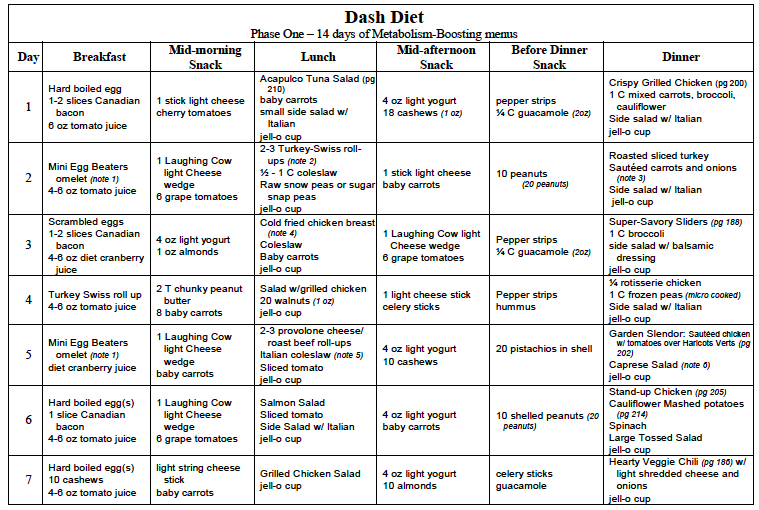Meal Plans
Phase 1: Two Weeks to Shrink Your Waistline
Day 1
Breakfast
Hard-boiled egg. (Hint: Make several
hard-boiled eggs, and peel. Store in a zipper bag in the refrigerator. Then you
will have them when you need them for super-quick breakfasts. You can also find
prepackaged, peeled hard-boiled eggs in some stores).
1 or 2 slices Canadian bacon
- 6 ounces tomato juice, low-sodium
Mid-morning Snack
- 1 stick light cheese
- Baby carrots
Lunch
- Acapulco Tuna Salad
- Cherry tomatoes
- Small side salad: dressed with Italian or oil and vinegar dressing
- Strawberry Jell‑O cup, sugar-free
Mid-afternoon Snack
- 4 ounces lemon light yogurt, fat-free, artificially sweetened
- 18 cashews (1 ounce by weight, 1/4 cup by volume, or small handful)
Before-Dinner Snack
(Optional)
- Pepper strips. (Hint: To make the strips quickly, cut off the tops and bottoms of some red, yellow, or orange bell peppers. Remove seeds and cut in half. Flatten each half and take a very sharp knife and cut along the surface, removing the membranes. Then cut into 1‑inch strips. These are great to dip into guacamole, as a chip substitute).
- 2 ounces guacamole, which is about 1/4 cup
Dinner
- Crispy Grilled Chicken
- 1 cup (or more) mixed carrots, broccoli, and cauliflower blend: steamed or microwaved
- Salad: Romaine blend with Italian dressing
- Raspberry Jell‑O cup, sugar-free
Day 2
Breakfast
- Mini-Egg Beaters Southwestern Style omelet. Spray microwave-safe dish or cup with cooking spray. Add 1/4-1/2 cup Egg Beaters Southwestern Style. Microwave on high for 1 minute. Stir, and cook an additional 15 seconds.
- 4-6 ounces tomato juice, low-sodium
Mid-morning Snack
- 1 light cheese wedge or 6 grape tomatoes
Lunch
- 2-3 Turkey-Swiss roll-ups. Cheese on the outside, as the wrap. Deli turkey slices for the meat. Add whatever condiments you like, such as mustard. You could also add lettuce as the outermost layer of the wrap.
- 1/2-1 cup coleslaw
- Raw snow peas or sugar snap pea pods (as much as you like)
- Orange Jell‑O cup, sugar-free
Mid-afternoon Snack
- 1 stick light cheese
- Baby carrots
Before-Dinner Snack
(Optional)
- 10 peanuts in the shell (20 individual peanuts) (Hint: Shelling nuts slows you down, so you are less likely to overeat them.)
Dinner
- Roasted sliced turkey
- Sautéed carrots and onions. Sauté 1 medium onion, thinly sliced, in 1 tablespoon olive oil or canola oil. Add about 8 ounces sliced carrots, and continue to sauté until the carrots are soft. Add 1 thin pat of butter at the end. (Hints: Top the turkey with the sautéed carrots for extra flavor. If you like very soft carrots, microwave first before sautéing.)
- Side salad topped with Italian dressing
- Lime Jell‑O cup, sugar-free
Day 3
Breakfast
- Scrambled eggs
- 1-2 slices Canadian bacon
- 4-6 ounces diet cranberry juice
Mid-morning Snack
- 4 ounces raspberry light yogurt, nonfat, artificially sweetened
- 23 almonds (1 ounce by weight, 1/4 cup by volume)
Lunch
- Cold fried chicken breast (don’t eat the skin or coating) [Hint: The chicken doesn’t have to be cold. This could be a fast-food lunch but only if you can choose whole chicken parts. (Definitely do not choose chicken tenders, patties, crispy chicken, or nuggets. They have too much breading for the amount of meat.) Most fried chicken places have coleslaw as a side. When you get back to your office, you can have the carrots and Jell‑O.]
- Coleslaw
- Baby carrots
- Lemon Jell‑O cup, sugar-free
Mid-afternoon Snack
- 1-2 light cheese wedges
- 6 grape tomatoes
Before-Dinner Snack
(Optional)
- Pepper strips
- Guacamole
Dinner
- Super-Savory Sliders
- 1 cup broccoli
- Side salad with balsamic dressing
- 1-2 strawberry Jell‑O cups, sugar-free
Source: http://what-is-the-dash-diet-plan.blogspot.sg/2013/02/dash-diet-meal-plan-phase-1.html#.Uso-nvZqFQA
This article is continuation of http://2eatdrinklivewell.blogspot.sg/2014/01/dash-diet-for-weight-loss-lower-blood.html
This article is continuation of http://2eatdrinklivewell.blogspot.sg/2014/01/dash-diet-for-weight-loss-lower-blood.html







